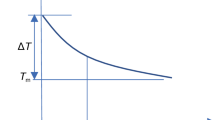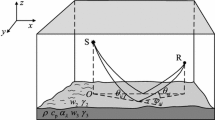Abstract
Traditional acquisition method of sound speed profiles using hydro-acoustic instruments is accurate but time-consuming and costly. To overcome this problem, some inversion methods have been developed over the last few decades. In this study, a comprehensive comparison of two inversion methods — the acoustic inversion method (AIM) and the satellite observation reconstruction method (SOR) — is presented. For AIM, the sound speed profile is first parameterized by the empirical orthogonal function (EOF) and the optimal parameters are searched by simulated annealing algorithm with respect to the cross-correlation function of the receiving signal and the simulation signal. For SOR, remotely sensed data are used to construct sound speed profiles. An experiment was conducted in the northeast of the South China Sea to verify the two methods. Both methods can obtain sound speed profiles quickly and cheaply. Compared with the sound speed profiles obtained by a conductivity-temperature-depth (CTD) instrument, the root-mean-square-error (RMSE) of AIM is 0.55 m s−1 and that of SOR is 1.71 m s−1. It is clear that AIM provides better inversion performance than SOR. Another primary benefit of AIM is that this method has no limitation to the inversion depth. The simulation results of sound propagation in regard to the inversed sound speed profiles show that the transmission losses of AIM and CTD are consistent and that of SOR is adversely affected by the inversion error of the sound speed and the inversion depth. But SOR has particular advantages in the inversion coverage. Together, all of these advantages make the AIM particularly valuable in practice.
Similar content being viewed by others
References
Abraham, D. A., 2019. Underwater Acoustic Signal Processing. Springer Netherlands, Switzerland, 95–156.
Bianco, M. J., Niu, H., and Gerstoft, P., 2016. Compressive acoustic sound speed profile estimation using wavelets. Journal of the Acoustical Society of America, 139(3): EL90–EL94.
Boden, L., and DeSanto, J. A., 1987. Sound speed profile inversion in the ocean. In: Progress in Underwater Acoustics. Merklinger, H. M., ed., Springer Netherlands, Boston, 319–327.
Chapman, C., and Charantonis, A. A., 2017. Reconstruction of subsurface velocities from satellite observations using iterative Self-Organizing Maps. IEEE Geoscience and Remote Sensing Letters, 14(5): 617–620.
Chapman, N. R., 2008. Inverse Problems in Underwater Acoustics. Handbook of Signal Processing in Acoustics. Springer Netherlands, New York, 1723–1735.
Charantonis, A. A., Badran, F., and Thiria, S., 2015a. Retrieving the evolution of vertical profiles of chlorophyll-a from satellite observations using hidden markov models and self-organizing topological maps. Remote Sensing of Environment, 163:229–239.
Charantonis, A. A., Testor, P., Mortier, L., Ortenzio, F. D., and Thiriab, S., 2015b. Completion of a sparse GLIDER database using multi-iterative Self-Organizing Maps (ITCOMP SOM). Procedia Computer Science, 51(1): 2198–2206.
Chen, C., Lei, B., Ma, Y. L., and Duan, R., 2016. Investigating sound speed profile assimilation: An experiment in the Philippine Sea. Ocean Engineering, 124(15): 135–140.
Chu, P. C., Wand, G. H., and Fan, C., 2004. Evaluation of the U.S. Navy’s Modular Ocean Data Assimilation System (MODAS) using South China Sea Monsoon Experiment (SCSMEX) data. Journal of Oceanography, 60(6): 1007–1021.
Fox, D. N., Teague, W. J., and Barron, C. N., 2002. The modular ocean data assimilation system (MODAS). Journal of Atmospheric and Oceanic Technology, 15(2): 22–28.
Jeffrey, N., Riser, S., and Wen, T., 2011. Interpreted acoustic ocean observations from Argo floats. Journal of the Acoustical Society of America, 129(4): 2400.
Jensen, F. B., Kuperman, W. A., Porter, M. B., Schmidt, H., and McKay, S., 2011. Computational ocean acoustics. In: Modern Acoustics and Signal Processing. Hartmann, W. M., et al., eds., Springer, New York, 155–230.
LeBlanc, L. R., and Middleton, F. H., 1980. An underwater acoustic sound velocity data model. Journal of the Acoustical Society of America, 67(12): 2055–2062.
Li, J., Shi, Y., Yang, Y., and Huang, X., 2022. Noise of internal solitary waves measured by mooring-mounted hydrophone array in the South China Sea. Journal of Marine Science and Engineering, 10(2): 222–235.
Li, J., Yang, Y., Shi, Y., and Liu, J., 2019. Estimation of sound speed profile from MODAS and its effect on sound propagation in the South China Sea. IEEE Oceans 2019. Marseille, 188–192.
Makris, N. C., Perkins, J. S., Heckel, S. P., and Catipovic, J., 1995. Optimizing environmental parametrization and experimental design for shallow water sound speed inversion. In: Full Field Inversion Methods in Ocean and Seismo-Acoustics. Modern Approaches in Geophysics. Diachok, O., et al., eds., Springer Netherlands, Dordrecht, 115–120.
Mao, Q. W., Chu, X. Q., Yan, Y. F., Qi, Y. Q., Wang, D. X., Gong, J. Z., et al., 2013. A three-dimensional temperature and salinity reconstruction system in the South China Sea. Journal of Tropical Oceanography, 32(6): 1–8 (in Chinese with English abstract).
Matsumoto, H., Haxel, J. H., and Dziak, R. P., 2011. Mapping the sound field of an erupting submarine volcano using an acoustic glider. Journal of the Acoustical Society of America, 129(3): 94.
Miller, A. B., and Miller, B. M., 2018. Underwater target tracking using bearing-only measurements. Journal of Communications Technology and Electronics, 63(6): 643–649.
Munk, W., 2006. Ocean acoustic tomography. In: Physical Oceanography. Jochum, M., and Murtugudde, R., eds., Springer Netherlands, New York, 119–138.
Sazontov, A. G., and Smirnov, I. P., 2020. Source localization in a non-uniform acoustic waveguide using the modal rank-reduction algorithm. Radiophysics and Quantum Electronics, 62(4):606–617.
Shen, Y., Ma, Y., Tu, Q., and Jiang, X., 1999. Feasiblity of description of the sound speed profile in shallow water via empirical orthogonal functions (EOF). Applied Acoustics, 2: 21–25.
Song, X., Li, H., Lin, X., Chen, X., Guo, X., and Tian, J., 2009. Sea experiments of the underway conductivity-temperature-depth prototype made in China. Journal of Ocean University of China, 8(4): 409–415.
Urick, R. J., 1983. Principles of Underwater Sound. 3rd edition. McGraw-Hill Book Company, New York, 79–112.
Wang, Y., Liu, Y., and Guo, Z., 2012. Three-dimensional ocean sensor networks: A survey. Journal of Ocean University of China, 11(4): 436–450.
Xu, T., Wang, J., Shi, W., Wang, J., and Chen, Z., 2019. A localization algorithm using a mobile anchor node based on region determination in underwater wireless sensor networks. Journal of Ocean University of China, 18(2): 394–402.
Yu, Y., Li, Z., and He, L., 2010. Matched-field inversion of sound speed profile in shallow water using a parallel genetic algorithm. Chinese Journal of Oceanic Limnology, 28(5): 1080–1085.
Zhang, M., Xu, W., and Xu, Y., 2016. Inversion of the sound speed with radiated noise of an autonomous underwater vehicle in shallow water waveguides. IEEE Journal of Oceanic Engineering, 41(1): 204–216.
Acknowledgements
This work was supported by the project funded by the National Natural Science Foundation of China (Nos. 419 06160, 11974286 and 12174312). We would like to thank Prof. Yiquan Qi for providing the information of satellite observation reconstruction method in this study.
Author information
Authors and Affiliations
Corresponding author
Rights and permissions
About this article
Cite this article
Li, J., Shi, Y., Yang, Y. et al. Comprehensive Study of Inversion Methods for Sound Speed Profiles in the South China Sea. J. Ocean Univ. China 21, 1487–1494 (2022). https://doi.org/10.1007/s11802-022-5001-7
Received:
Revised:
Accepted:
Published:
Issue Date:
DOI: https://doi.org/10.1007/s11802-022-5001-7




